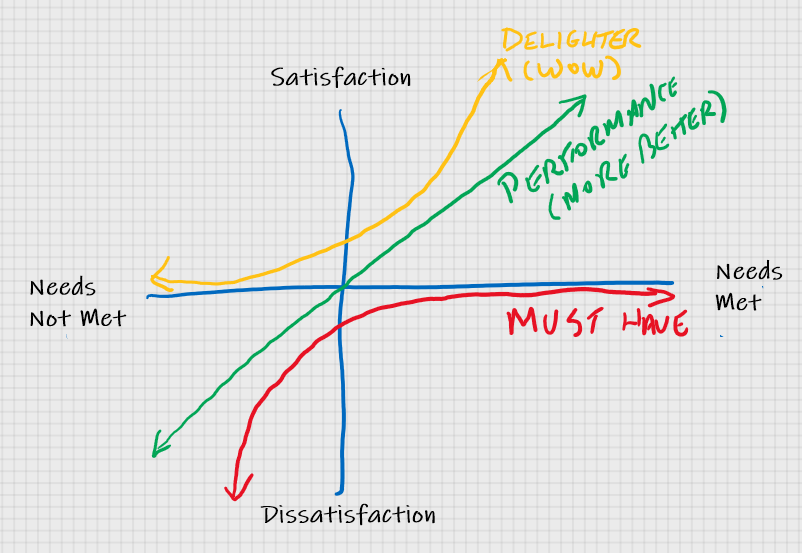Prioritization & Planning
Kano Model:
The Kano Model is a product development framework designed to help with the prioritization of product features based on customer needs and satisfaction. It is through this lense that features are categorized as either a must-have, performance related, or a delighter.
Cars are a useful example to help illustrate each bucket:
- Must-haves: Tailights, headlights, and seatbelts are all must-have features. You won’t sell too many cars without them, but they also aren’t differentiators—plush seat belts are not a thing.
- Performance: Engine type, output power, mileage, and suspension ride characteristics can dramatically impact one’s ride experience. These obviously can be valuable selling features and are typically targeted at distinct market segments.
- Delighters: Heated seats, remote start, navigational support, these are delighters. They give that little extra “oomph” that rachets up the appeal level, helps create product stickiness, and used to justify premium pricing.
Having the right mixture of these feature elements is key.

The Kano Model can be used anytime during a product lifecycle but it is most useful during the initial product development phase when the right features need to be prioritized.
Consider using when:
- Prioritizing feature development
- Looking for opportunities to improve customer satisfaction
- Evaluating new product opportunities.
References: Guide to the Kano Model | What is the Kano Model | Using the Kano Model | Kano Model Analysis | PM guide to Kano
MoSCoW Method
The Moscow Method is a process to help identify what matters most to stakeholders AND to customers by classifying features/tasks/stories into four priority buckets:
- Must have…
- Should have…
- Could have…
- Won’t have…
- Works best when:
- A large number of tasks need to be prioritized
- Once confident scope is fully understood
- Can be done (ought to be done?) as physical group exercise
- BENEFIT => produces a clear & shared sense of direction and priorities …in some cases, it can be used as an outline for MVP
References: Power of the Moscow method| Intro to Moscow | How to prioritize with moscow
RICE
Helps with prioritization by scoring projects/features according to the RICE acronym:
- (Reach) - how many customers will the project/feature impact over given time period?
- (Impact) - measurable impact to cust/biz - increase in sales, cust. sentiment, etc
- (Confidence) - your level of confidence (%) in your data
- (Effort) - Resource need to build
Basic equation => (RxIxC)/E = Rice score
- Value: Method to objectively weigh competing projects against each other
- Pros: the stated value above & it requires product teams to make product metrics SMART (reach component)
- Cons: dependencies are not considered, it is still an estimation game (ie confidence)…
References: Intercom, Productboard ProductPlan
Story Mapping
Story mapping is a method of arranging user stories to create a complete view of the user’s experience/journey
- Collaborative, involves the whole team
- Personas and what are they trying to accomplish
- Value: prioritizes the right work, can deliver value early and often, exposes risks & dependencies
- Cons: doesn’t consider external factors like business value and complexity, not rooted in a customer problem
- Useful for MVP <-> Ongoing Dev
References: What is story mapping1, What is story mapping2, How you slice it, The New User Story Backlog is a Map
Value vs. Effort (complexity)
Objective method to prioritize projects based on value/effort score
- AKA 2x2 Priority matrix, see also Eisenhower Matrix
- Value - benefit your customers & biz get out of the project
- Effort (Complexity) - your resources expense
Basic equation => Value/Effort = Priority

References: ProductPlan, Roadmunk, Hygger
Weighted Scorecard
Ranks projects/feature against defined drivers (can be benefit & cost categories).
- Define drivers (benefit/cost considerations) and assign % weight to each, totalling across to 100%
- Review projects/features, assign value 1-100 for each driver
- For each project/feature, multiply value to driver weight for each driver & total
- Rank based highest to lowest totals
References: 280group, Product School - normalized ex, MindtheProduct
Other Methods
- Cost of Delay - helps place focus on speed & value
- Opportunity Scoring - (aka Opportunity Analysis) uses a satisfaction & importance graph to measure and rank opportunities
- The Product Tree - (aka pruning the product tree)